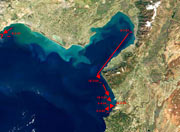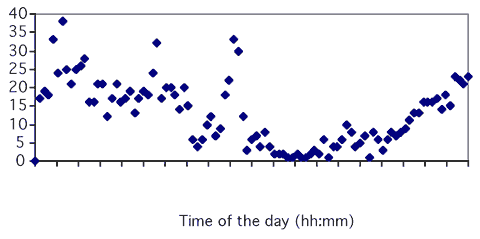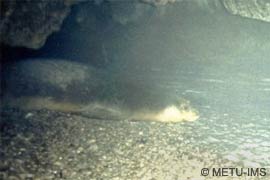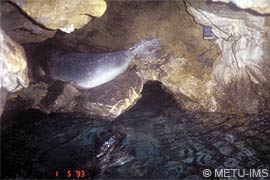

 |
||
 |
||
Vol. 7 (1): June 2004 |
Download this article
|
|
ARAB THE PILGRIMAli Cemal Gucu and Meltem OkMiddle East Technical University
|
 |
|
|
Figure 1. The locations of the recent seal sightings in the Levant Sea. |
Later, the network enabled the METU-IMS team to track this male seal along his way to the Syrian border where he now seems to have settled (see Figure 1). According to the local fishermen, without whom the data would have never been collected, this is typical behaviour of the seals sighted in the area. On irregular intervals, seal(s) are sighted, stay in the area for 10 to 20 days and disappear for a long while. A female sighted last year at the same place, bearing wounds at the rear part of her body, (descriptions given by the observers are identical to mating wounds on a female) indicates that the area is not only visited by the same individual.
Now, within the framework of the new monk seal research project jointly carried out in the Gulf of Iskenderun by METU-IMS and BTC Co Pipeline company [see Perspectives, TMG 6 (2): December 2003], the caves in the area that are suitable for seal use were equipped with infrared monitors. This is essentially the same approach that had previously been successfully applied to understand cave use patterns and for photo-identification of the seals along the Cilician coast. There, TrailMaster infrared monitoring systems were used to monitor seal activity in caves. The system has three components: a transmitter, a receiver and a 35-mm camera with a built-in flash. The transmitter and the receiver were set and aligned 20–30 cm above the floor of the cave and the camera was placed in a location that permitted the best view of the seals. The transmitter emitted infrared pulses every 0.05 s and the receiver recorded an event when the infrared beam was broken for a second or longer (20 consecutive missed pulses=1.0 s). This value was short enough to record a seal’s passing through the beam and long enough not to record a false event such as those caused by flying bats, water splashes, etc. Each event was stored in the receiver by date and time. The receiver automatically activated the camera when an event occurred. To prevent depleting the entire roll of film by multiple events occurring shortly after one another, the camera was delayed for 90 min after an event. Infrared monitors and cameras were installed in the three most actively used caves but two of the systems were destroyed during a storm. Data from two of the caves were disregarded, as the collection could not be applied for a complete year due to mechanical damage. The data recorded at cave Dehliz were later analysed for activity patterns (Figure 2).
 |
|
Figure 2. Activity patterns at cave Dehliz. |
Seal photographs from three of the caves were used for individual identification. The female seen in Photo 1 is recognized by the dense mating scars on the back and circle shaped mark on her left shoulder.
 |
|
Photo 1. Caught on camera: a female seal with dense mating scars. |
Of particular importance to identification criteria , the pictures also provided useful information on the colour ranges of individuals. revealing how pelt colour may change within a couple of hours and turn from black to light grey (Photo 2 and 3) due to drying.
 |
 |
|
|
Photo 2. The camera picks up the change in pelt colour, from black… |
Photo 3. … to light grey. |
In another instance, a cave lacking a suitably large platform on which a seal could comfortably rest, and hence not initially considered important by the research team, was later proven by the monitoring system to be the most actively used cave in the area (Photo 3). Careful scrutiny of this photograph reveals not only the individual on the platform, but also the flipper of a second seal in the water. A third individual can just be made out at the anterior of the seal on the platform. The greatest number of seals that researchers have observed sleeping side by side on the platform is 4.
 |
|
Photo 4. A member of the research team ‘hauls out’ to demonstrate the size of the platform. |
If the male seal is caught by the monitors during his current stay in the Iskenderun region, the images obtained will be compared with those recorded in the Cilician Basin to determine whether the migratory seals sighted in the Levant Sea are, in fact, members of the same colony. If the hypothesis proves correct, and if the male recently sighted in the Gulf of Iskenderun is a member of the Cilician colony, it is unlikely to be anyone else but Arab, who by now has attained sexual maturity. Although the reasons why seals in the Levant Sea migrate is still unclear, the journey of Arab may be another compelling piece of evidence for territorial behaviour in the Mediterranean monk seal.
Copyright © 2004 Ali Cemal Gucu, Meltem Ok ,The Monachus Guardian. All Rights Reserved |